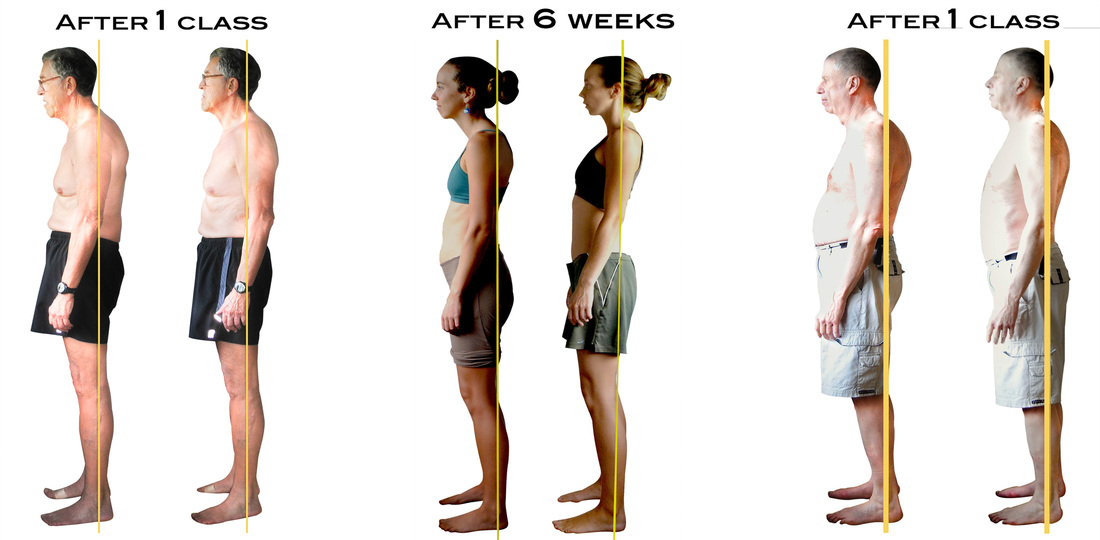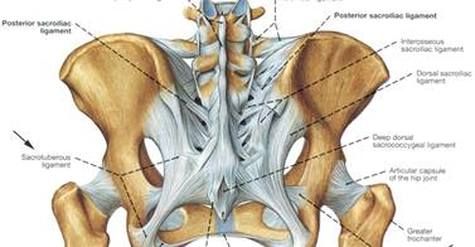Exercise for good posture, not good posing.
 Via Michaelle Edwardson Aug 27, 2013 Many fitness positions reinforce bad posture and go against our natural curves. Chronic pain is directly related to poor posture. In fact, according to Cedar Sinai Spinal Institute, 95% of pain is a result of dysfunctional alignment. Many a sore back is blamed on too much time sitting at a desk, but exercises that put our body in right angle positions that simulate the chair shape are just as harmful. These exercises make up a large percentage of our current Yoga, Pilates and fitness exercises. With a little bit of awareness, we can avoid distorting our natural shape and instead move with the curves of our body. Two simple tests may determine whether an exercise or yoga pose serves the human design: it should allow the spine to have its natural curves, and it should not cause restricted breathing. These are common positions and exercises that distort our natural alignment, creating more pain and joint destabilization: • Sitting in chairs with poor posture. This puts the spine in a C-shape with its natural curves reversed. • Toe-touching with knees straight while standing or sitting, like the yoga forward bend. Try walking around without bending your knees! It’s like driving with your parking brake on. • Forced abdominal exercises that direct us to keep the navel drawn in to tighten the six-pack. Chronically tight, short abs can inhibit movement and distort posture, breathing and digestion. • Positions that create a right angle, such as the yoga staff pose, straight leg standing or seated bends, and the yoga shoulder stand and plow pose. These are non-functional body positions that can overstretch nerves and ligaments, as well as compress spinal discs. Our spine is not made to bend like this. Keep your curves, and bend your knees when doing any forward bending. Ask any toddler how, they are the posture gurus. • Cycling, paddling and spinning with your spine in a C shape. Why would you want to strengthen poor posture habits? • Tucking the tailbone requires one to draw in the abs, creating chronic shortness of the trunk, compressed lumbar spine and a flat butt. Tuck your tailbone and try running a marathon! There are no straight lines in nature. The human spine is curved to provide shock absorption, protect our nerves and joints, and also allow us to move with fluidity. When we do exercises that flatten our spine, we are overriding our natural design. Because man likes to build in straight lines and right angles, we have begun to think the body is flat as well. We have built chairs, but everyone hates to sit for a long time because our trunk is not designed to be static in a right angle shape, so we fall into a supported slouch. This pushes our head forward, and we strain our upper neck and shoulder muscles to support the weight. The strain culminates in chronic pain, headaches and countless other maladies. There are hidden dangers in right angle positions. The right angle position drains our energy, as muscles are engaged to perform functions they are not designed to do. Many of us get very dysfunctional upper shoulder breathing habits when we sit or exercise this way. Many yoga poses and fitness exercises put us in a similar poor postural alignment, and then we work hard to train our body to hold the abnormal tension of the positions. Yoga and stretching injuries are on the rise because many of the poses go against our natural shape and curves. This leads to abnormal levels of flexibility and joint destabilization, especially in the lumbar/sacral region. Hip replacement surgeries are happening to more and more yoga and fitness practitioners. YogAlign is based on eliminating unnecessary tension in the body and waking up dormant postural forces that align you from the inside out. No need to do painful stretches or toe-touching poses as this makes no anatomical sense. We need to learn how to balance tension forces in the body, rather than pulling on our parts in an attempt to balance the big posture picture. The six-pack is highly overrated and can lead to more pain. Popular abdominal exercises are designed to make our belly strong, sexy, and tight. Culture places heavy focus on our outer belly—our six-pack. Toning the six-pack to be flat, however, can inadvertently create an unnatural shortened tension that brings our breastbone towards our pubic bone and draws our head and shoulders forward in misalignment. The shorter we make the front, the more strained and exhausted our back muscles are. Forward head carriage is a national epidemic, a bad posture habit that leads to chronic pain. To be pain-free, one can use breathing exercises to strengthen the “K.E.G.” or ribcage muscles, which has far more functional value. Good posture is a natural result of doing exercises and poses that simulate your body’s innate curving shape. It is imperative in the daily movements through which we live in our bodies. When alignment is not balanced, the whole body suffers from pain, tension, and eventually the deterioration of the joints. To be pain-free, you need to learn to engage your body in its natural design, sit with actively curved spine engagement, but also make sure that your exercise supports good posture and not good poses. Align, don’t contort.
0 Comments
 Yogis need to take care, as many people are unknowingly damaging their body by doing yoga twists without honoring the spine’s natural structure, which is made of curves—not straight lines. The spinal column is a dynamic, flexible rod acting as a support structure for our body and nerves. The basic design is four opposing curves: neck, upper back, lower back and tailbone, allowing our trunk to flex, extend and twist. In positions without these curves, twisting movement becomes difficult, and flexibility comes at the cost of overstretched spinal ligaments, compressed or herniated discs and even compression fractured vertebrae. While most people are aware that one should avoid yoga twists when there is disc herniation or nerve impingement, many yoga twists require complex body positions that can reverse the curves of the spine, causing damage to an otherwise healthy body. The human spine consists of 24 vertebrae that vary in size, shape, and function, separated and cushioned by discs which help to create shock absorption to protect our joints as we move, as well as providing a framework to support our nerves. When we are born, we have a C shape to the spine that consists of one primary curve forwards, which makes it necessary to support a baby’s neck until he gets the muscle actions that create the spinal curves. As he begins to lift his head from the belly down position, extensor muscles in the back body from sacrum to skull, engage and create the secondary backwards curves of the lumbar (lower back) and cervical (neck area). For FULL article click HERE.  The 20-some students were earnest, curious and right on board with our slower-than-usual approach to asana practice, and our emphasis on meditation and philosophy. I am inspired to know that this group of teachers is bringing their wisdom into the world of yoga. Early in the training, one student who had been teaching in a fitness studio asked a very important question. She explained that one of her female students became unusually flexible prior to ovulation (probably because of the presence of relaxin, a hormone that relaxes the ligaments that hold together the various joints in the pelvis—hip joints, sacroiliac joints and pubic symphisis). The teacher said that she encouraged the student to move farther into poses at that period in her cycle since she was already more flexible. “Should I continue doing this?” she asked. Twenty years ago I would have said yes. In fact, I did encourage women to take advantage of their relaxin-induced flexibility during pregnancy. No more. Fortunately, the third time I took anatomy the importance of understanding the structures of ligaments and tendons finally sank in. (For clarification, ligaments connect bone to bone in our joints; tendons connect muscle to bone at the joints.) Ligaments and tendons are constructed of dense, regular, collagenous, connective tissue. Ligaments are dense, fibrous tissues that are designed to limit the movement of our joints. Please repeat this three times: Ligaments are designed to limit the movement of our joints. This is also very important: ligaments and tendons are considered to be avascular, i.e. containing no blood flow of their own. Oxygen and other nutrients diffuse into ligaments and tendons from cells outside the tissues. Because these structures need to be strong, they are largely comprised of collagen fibers with some elastin to create a small amount of stretch. For full article click HERE.  "Anityasuciduhkhanatmasu nityasucisukhatmakhyatiravidya" (What at one time feels good or appears to be of help can turn out to be a problem; what we consider to be useful may in time prove to be harmful.) -- From Patanjali's Yoga Sutras, written in Sanskrit approximately 2,400 years ago. As a 40-year yoga practitioner, with over two decades practicing massage therapy and teaching yoga, I have seen countless injuries, chronic pain and joint issues in yoga clients of every age and fitness level. My work and investigations with yoga injuries has revealed certain yoga poses engage the body in positions that are unnatural for the design of the human body. In this series of posts, I will explain why these poses need to be radically modified or eliminated to protect yoga practitioners from finding out that which was considered to be useful may in time prove to be harmful. The sad truth is that years of practicing body positions that do not simulate real life function can lead to misalignment, chronic pain, and even surgical replacements. To be smart and safe in yoga, we need to consider postural alignment and natural joint function, rather than blindly following a list of "must-do" traditional poses and boot camp challenges. To read full article from YogAlign inventor, Michaelle Edwards click HERE. |
ArchivesCategories |
 RSS Feed
RSS Feed